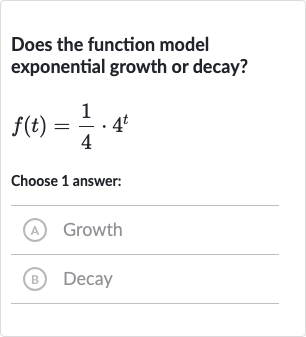Full solution
Q. Does the function model exponential growth or decay?Choose answer:(A) Growth(B) Decay
- Base of Exponent: Step : To determine if the function represents growth or decay, we need to look at the base of the exponent. In the function , the base of the exponent is .
- Exponential Growth or Decay: Step : If the base of the exponent is greater than , the function models exponential growth. If the base is between and , the function models exponential decay.
- Exponential Growth Determination: Step : Since the base of the exponent in our function is , which is greater than , the function models exponential growth.
- Coefficient Impact: Step : The coefficient in front of the exponential function does not affect whether the function is growth or decay; it only affects the scale of the function.
More problems from Interpret the exponential function word problem
QuestionGet tutor help
QuestionGet tutor help
QuestionGet tutor help
QuestionGet tutor help
QuestionGet tutor help
QuestionGet tutor help
QuestionGet tutor help
QuestionGet tutor help
QuestionGet tutor help

